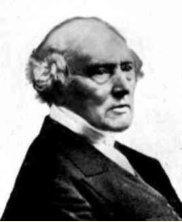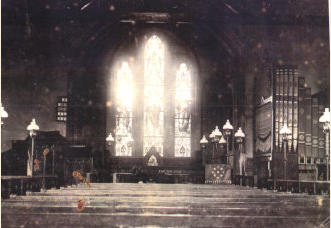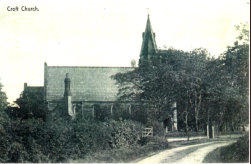
at Christ Church Croft
The history
The building
Origins
Christ Church was built in 1832-1833 as a chapel of ease to the Mother Church of Winwick. It occupies a position in what is probably one of the highest parts of the village. The Church is of Gothic design with a spire designed by one of the foremost architects of the day, E. Blore, Esq., and built by James Pierpoint at a cost of £2,667.00, of which the Parliamentary grant provided £1,457.00, the remainder being raised locally. Mr. Samuel Barrow gave the land for the Church & Churchyard; the Church was consecrated by the Bishop of Chester (in whose diocese Croft then was) on 29th November 1833. The present site was chosen as being a mid-point between Croft and Risley who’s two communities it was built to serve. The sandstone for the building was transported by the Croft farming community from Delph Lane. In the Churchyard near the road stand two stone pillars which were once the sides of the Croft stocks. Croft became a parish in its own right in 1845. The seating capacity was 518, made up of 226 in paid pews and 292 free. In 1904 the old high-backed pews in the nave of the Church were replaced by the present Oak pews. The stone flagged floor was also replaced by the present wood block one. A new heating apparatus with pipes and radiators round the walls was introduced at the same time; this was replaced in 1957 by an off-peak electrical system. In the year 1999-2000, when the Church was totally refurbished a new oil fired heating system was installed. Restoration The Church spire was overhauled in July 1910, the decayed stonework being renewed, the cracks made good with mastic cement down to the square, total for the same being £25 which included making safe the lightning conductor. Mr. Silas Clough provided a notice board fixed near the North door of the Church (to replace the old one). In the years 1962-1963 a much needed general restoration of the exterior fabric of the Church was undertaken. New drains were inserted at the base of the foundations of the North wall to try to eliminate the constant dampness. The interior walls were re-plastered where necessary and the whole interior of the Church re-decorated. The lighting system was tested and where necessary renewed. The total cost of this work was £3750. NB. The history of the Church given here largely draws on that written by Mr. Peter Ingham in 1934. Mr Ingham was a Churchwarden for some 50 years. The incumbents The first Curate at Christ Church Croft was Benjamin Banning, from 1833. He left Croft in 1838 to become Curate at St. John’s Liverpool staying until 1841. He was appointed Vicar of Wellington, Salop in 1841 and he remained in that post until 1881. Thomas Penyngton Kirkman, a distinguished mathematician and a Fellow of the Royal Society, was Curate from 1839 until 1844, when he became the first Rector of Croft. He held that position until 1892 when Henry Isaac Wadeson took over. During his Incumbency of 41 years every part of the Church, with the exception of the stone walls, was renewed, and much of the beautiful decoration of the Church and Organ was the work of his own hands. In his early days Mr. Wadeson took an active interest in sport: walking, wrestling and boxing being amongst his accomplishments. He was fond of cycling and a great lover of nature, particularly birdlife. An eloquent and gifted speaker, he was much in demand for Harvest Festivals in neighbouring villages and towns. He was of powerful build and until a few days before his death on 17th March 1933 enjoyed robust health. Mr. Wadeson is buried in the Churchyard. From 1933 the Rector was Samuel Barrow; during his short time as Rector he devoted much of his energy into raising a memorial to his predecessor. He was an Evangelical Churchman of considerable musical ability and in keeping with the traditions of the Church ensured his services were as bright and beautiful as possible. He died on the 4th of January 1936 and is buried in the Churchyard. From 1936 the Rector was William Chadwick, during his incumbency the Abdication crisis of 1936 and the Coronation celebrations of the following year took place. He was Rector for most of the Second World War and as such saw many of his congregation leave for active service. He resigned in 1943 and moved to London joining his son who was Vicar of Crouch End. From 1944, the Rector was Herbert Alexander Carlyle Hughes L.LB. During his 26 years as Rector he saw the former Memorial Institute replaced by the present Memorial Hall, in fact he played an active part in bringing this about. He was appointed Rural Dean of Warrington in 1957, he held this position until his death on the 4th June 1970. He was buried with his wife in the Churchyard of All Saints, Rainford. John Alexander Woolley was the Rector from 1971 until 1975 when he resigned to become the Chaplain of Ryhope Hospitals in Sunderland. John Taylor became the Rector in 1975 and remained until his death on the 12th September 1978. He his buried in the Churchyard at Christ Church Croft. From 1979 the Rector was Richard H.L. Williams who remained as Rector until his move to Wavertree, Liverpool in 1989. Peter Thorn became the Priest-in-charge in 1990 until 1992 when he moved to Streatley in the Diocese of St Albans. From November 1992 the Priest-in-charge was Wilfred Alexander who elected in 1999 to become the Assistant Priest-in-charge at Croft and Newchurch. The Rev. Alan Litton Rector of Newchurch filled the position of Priest-in-charge at Croft. The Rev. A Litton resigned from the joint benefice of Croft and Newchurch on the 6th October 2002. On the 6th July 2003 the Rev. Dr. Christopher Stafford was appointed as Rector, having been Curate of St. Philip’s, Westbrook. He had previously studied at Birmingham University and read Biological Sciences, going on to obtain a PhD in Plant Cell biology. In 1991 he spent a year with Birmingham City Mission working with homeless people, later working with victim support at Birmingham Crown Court.
© Lorem ipsum dolor sit Nulla in mollit pariatur in, est ut dolor eu eiusmod lorem 2012












Kirkman’s schoolgirl
problem
Kirkman's schoolgirl problem is a problem in combinatorics proposed by Rev. Thomas Penyngton Kirkman in 1850. The problem states: ‘Fifteen young ladies in a school walk out three abreast for seven days in succession: it is required to arrange them daily so that no two shall walk twice abreast’.The solution?
Can be found at the foot of this page!
The solution
If the girls are numbered from 01 to 15, the following arrangement is one solution:
Sun. Mon. Tues. Wed. Thurs. Fri. Sat. 01, 06, 11 01, 02, 05 02, 03, 06 05, 06, 09 03, 05, 11 05, 07, 13 11, 13, 04 02, 07, 12 03, 04, 07 04, 05, 08 07, 08, 11 04, 06, 12 06, 08, 14 12, 14, 05 03, 08, 13 08, 09, 12 09, 10, 13 12, 13, 01 07, 09, 15 09, 11, 02 15, 02, 08 04, 09, 14 10, 11, 14 11, 12, 15 14, 15, 03 08, 10, 01 10, 12, 03 01, 03, 09 05, 10, 15 13, 15, 06 14, 01, 07 02, 04, 10 13, 14, 02 15, 01, 04 06, 07, 10 A solution to this problem is an example of a Kirkman triple system.
Rev Henry Isaac Wadeson
Rector 1892 - 1933

Rev William Chadwick
Rector 1936 - 1943

Christ Church pre 1904. Note side aisles and the old organ.


The old Croft Smithy (now The Horseshoe Inn)

Lady Lane, looking towards the Church










